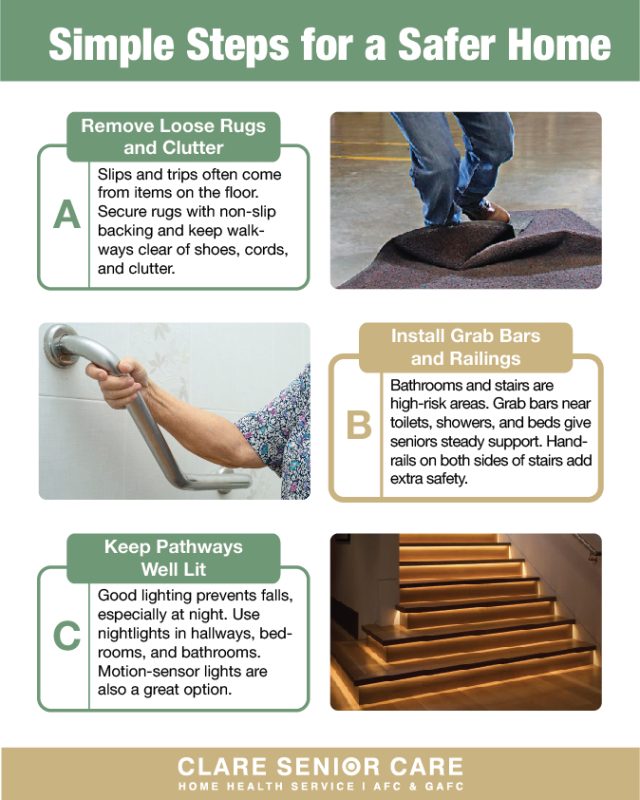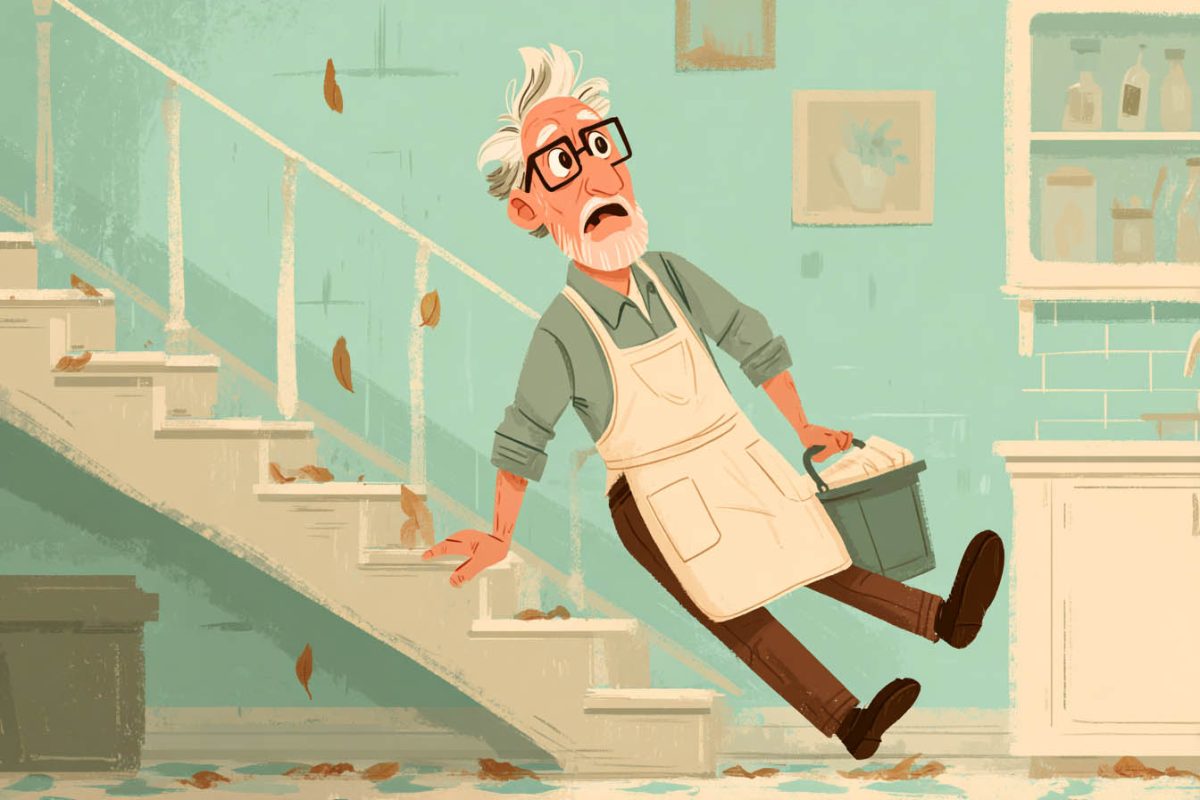Every 19 minutes, a senior dies from a fall. One in four U.S. adults 65+ falls each year. Every 11 seconds, a senior is treated in the ER for a fall.
Falls aren’t an inevitable part of aging—they’re often preventable. Many hazards hide in plain sight: cluttered walkways, loose rugs, dim lighting, missing grab bars, and high-risk areas like bathrooms and stairs. With a few smart home changes and steady daily routines, caregivers can dramatically cut risk and help seniors move with confidence at home. Act early: watch for small warning signs—hesitating on stairs, difficulty rising from a chair, or unexplained bruises—and tune up the home and habits before a crisis.
Read More: Dementia Awareness: A Practical Guide for Families & Caregivers
1. Why Fall Happens
A fall is rarely caused by one thing. It’s usually a mix of health changes, environmental hazards, and daily habits. Caregivers are the first line of defense: noticing subtle changes in gait, strength, or confidence and taking action early.
Daily Activities of Daily Living (ADLs)—like bathing, dressing, toileting, transferring, walking, and eating—are a good way to understand risk. When a person needs help with ADLs, fall risk tends to rise, which is why programs like AFC/GAFC use ADLs to measure need and support. Bathrooms are a special concern: even someone who “can” bathe may not be safely able to do so without supervision; arthritis, pain, and limited reach make washing and shampooing difficult, and most falls happen in bathrooms.
2. Common Risk Factors
2.1 Health-Related Risk Factors
- Weak muscles & limited mobility. Aging reduces strength and flexibility; inactivity accelerates the loss of balance.
- Chronic conditions. Diabetes, arthritis, Parkinson’s, and heart disease can slow reflexes, cause pain, and affect balance.
- Poor vision or hearing. Trouble detecting steps or hearing warnings raises risk—annual checks help.
- Medication side effects. Dizziness, drowsiness, and low blood pressure (especially with multiple drugs) can trigger falls.
2.2 Environmental Risk Factors
- Unsafe home setup. Loose rugs, clutter, poor lighting, and slippery bathroom floors.
- Lack of safety supports. Missing grab bars, unsteady railings, and no non-slip mats.
- Footwear & flooring. Socks on hardwood, loose slippers, or slick soles often lead to slips.
2.3 Lifestyle & Behavioral Risk Factors
- Low physical activity. Less movement means weaker balance and higher risk.
- Fear of falling. Avoiding activity due to fear actually worsens mobility and increases risk.
- Rushing or inattention. Quick moves—answering a phone or hurrying to the bathroom—can cause sudden trips.
3. Simple Steps to Prevent Falls
3.1 Home Safety Adjustments
Start with the easiest wins:
- Clear walkways. Remove clutter, cords, and small furniture from common paths.
- Secure or remove loose rugs. Non-slip pads or removal reduce trip points.
- Improve lighting. Nightlights in hallways, bedrooms, and bathrooms; consider motion-sensors.
- Install supports. Add grab bars near toilets and in showers, railings on both sides of stairs, and non-slip shower mats.
- Think like a visitor. Walk through the home with “fresh eyes” and fix dark corners, cords, or tight spaces (especially in bathrooms and on stairs).

3.2 Healthy Habits for Stability
Build body and brain resilience with daily routines:
- Stay active. Encourage short walks, stretching, and simple balance exercises daily—small, consistent movement builds strength.
- Wear safe footwear. Choose firm, non-slip soles; avoid socks on slick floors.
- Schedule annual vision & hearing checks. Small corrections (new lenses or hearing aids) can significantly improve safety.
- Review medications regularly. Ask the clinician or pharmacist about dizziness or blood-pressure dips; adjustments can lower fall risk.
- Use technology wisely. Tablets with reminders, safety alerts, and personal emergency response systems (PERS) can help, especially at night.
Key idea: prevention beats reaction. Waiting until after a fall can cost confidence and mobility; every secured rug, brighter light, and encouraged walk is an investment in dignity and independence.
3.3 Smart Caregiver Strategies
Caregivers are partners in fall prevention:
- Spot small changes early. Slower walking, uneven steps, or hesitation signal growing risk—act before a fall.
- Encourage, don’t hover. Support safe use of canes/walkers and independent movement to build confidence.
- Prioritize bathroom safety. Supervise or assist during showering when needed; many falls occur in bathrooms, especially with arthritis or limited reach.
- Use ADLs as a guide. If help is needed with bathing, dressing, toileting, transferring, walking, or eating, build extra safety supports around those activities.
- Document and coordinate. Caregivers keep daily logs, report changes, and work with Clare’s nurse and case manager to keep plans on track.
- Count on regular professional visits. AFC Level I members receive alternating monthly touches from nurse/case manager; Level II members receive both each month—an extra layer of monitoring for safety needs and home adjustments.
- Plan for emergencies. Teams develop backup and contingency plans so support is available if a caregiver is temporarily unable to provide care.
Summary
Falls can be prevented through a balanced approach: remove hazards at home, build strength with daily movement, check vision/hearing, review medications, and use simple tech like PERS where needed. Caregivers play the central role—spotting risks early, supporting safe independence, and partnering with nurses and case managers. With a few practical adjustments and a proactive mindset, seniors can stay safer, more confident, and more independent at home.
Disclaimer
This educational content is for general information only and does not replace medical advice, diagnosis, or treatment. Always consult your clinician or emergency services if you have urgent safety concerns. Program features, eligibility, and visit schedules may vary based on MassHealth rules and individual care plans.
Join Clare’s Fall Prevention Awareness Event to learn hands-on home safety tips, simple balance routines, and caregiver checklists. You’ll also get access to Clare’s Fall Prevention Program inside the Client Portal with short lessons, safety checklists, and videos. Click to book your spot now.


